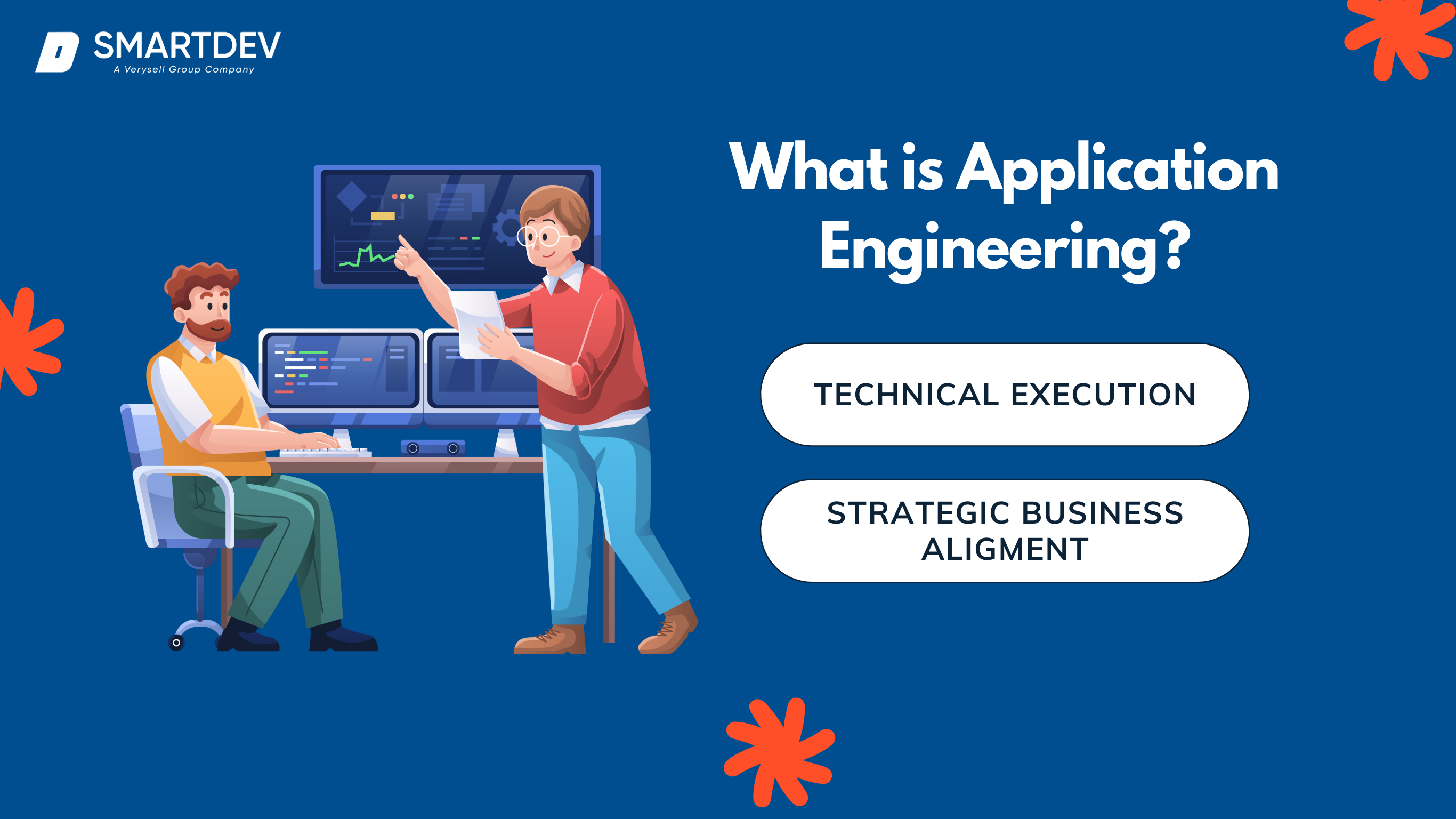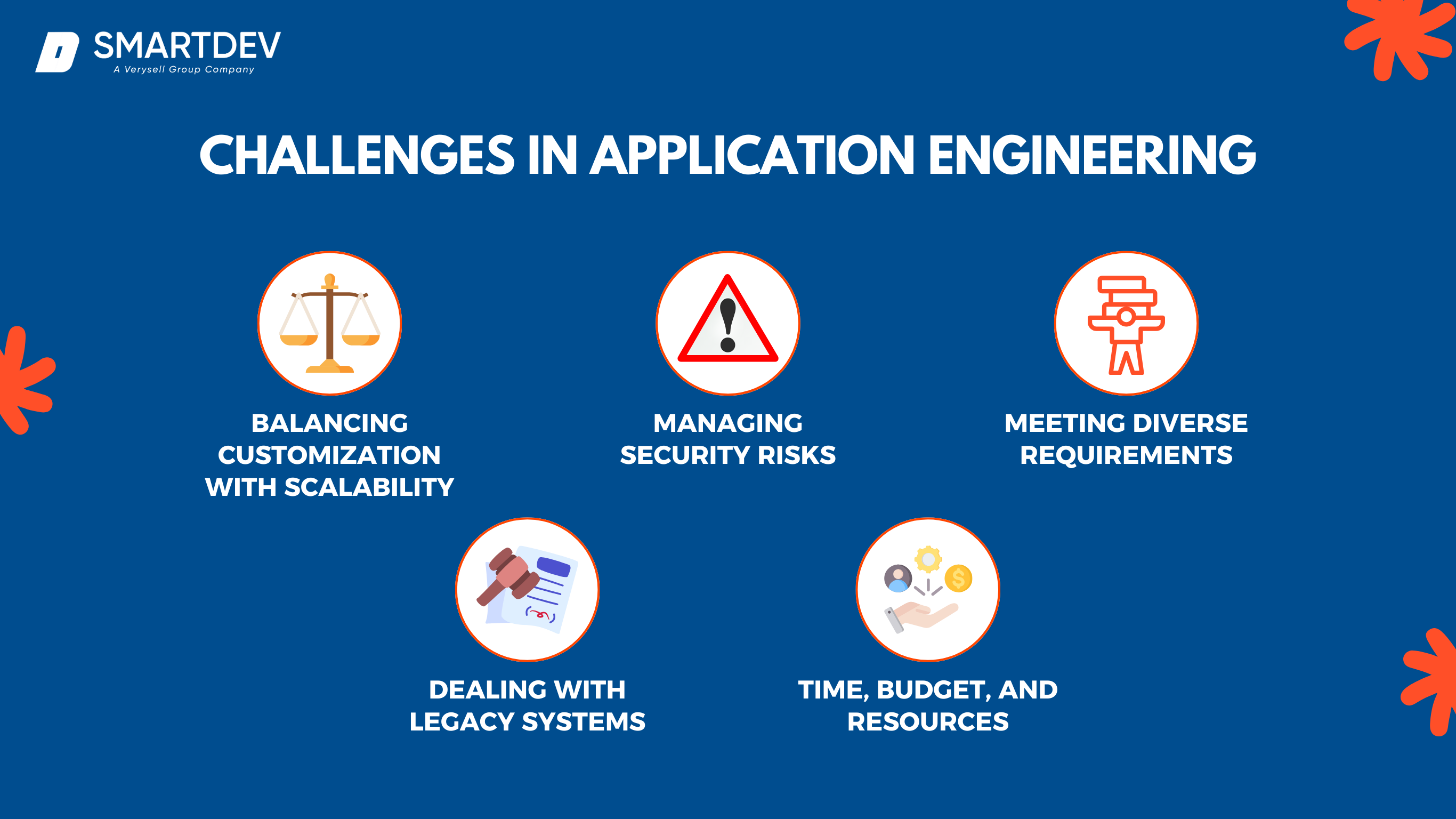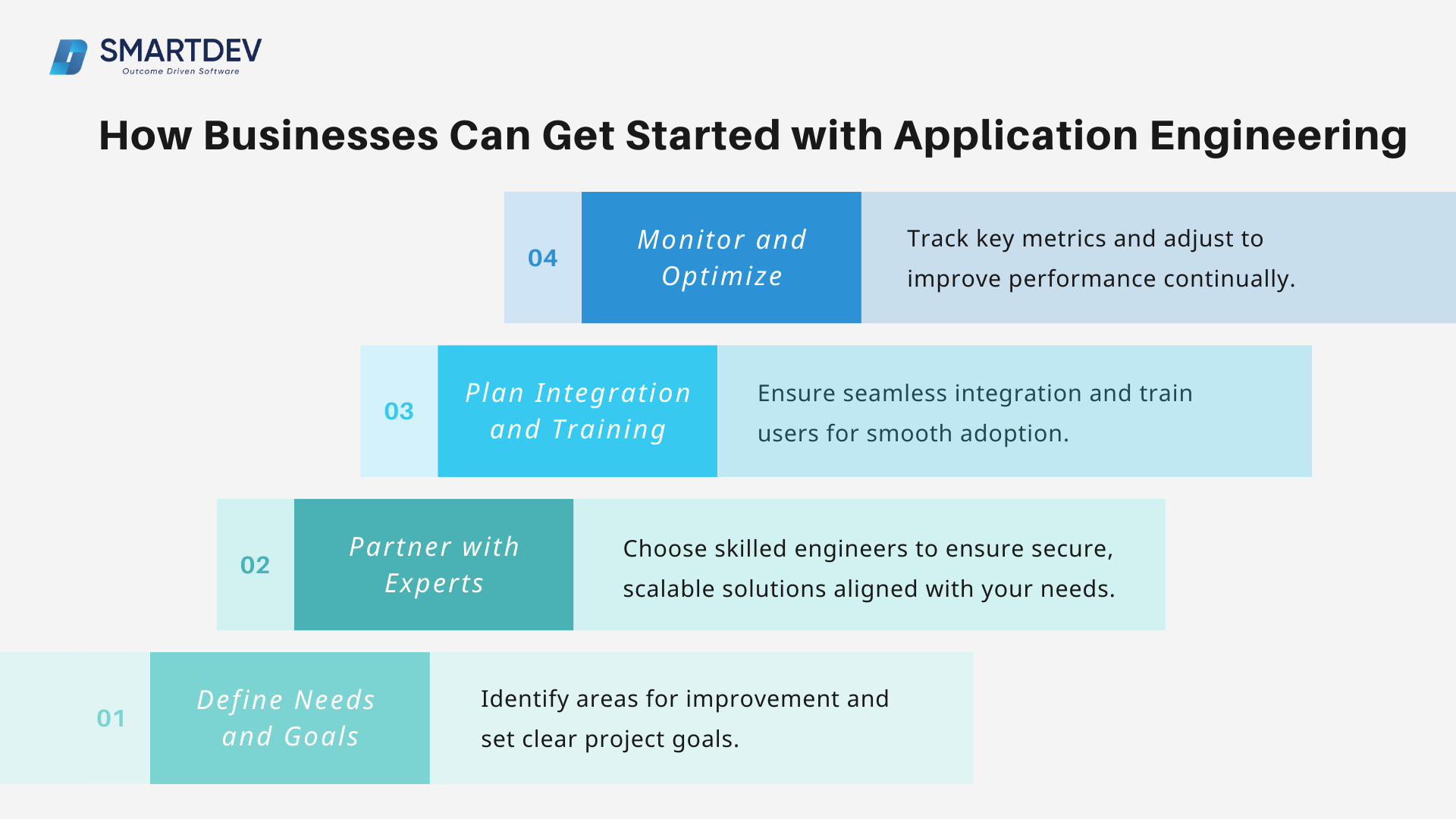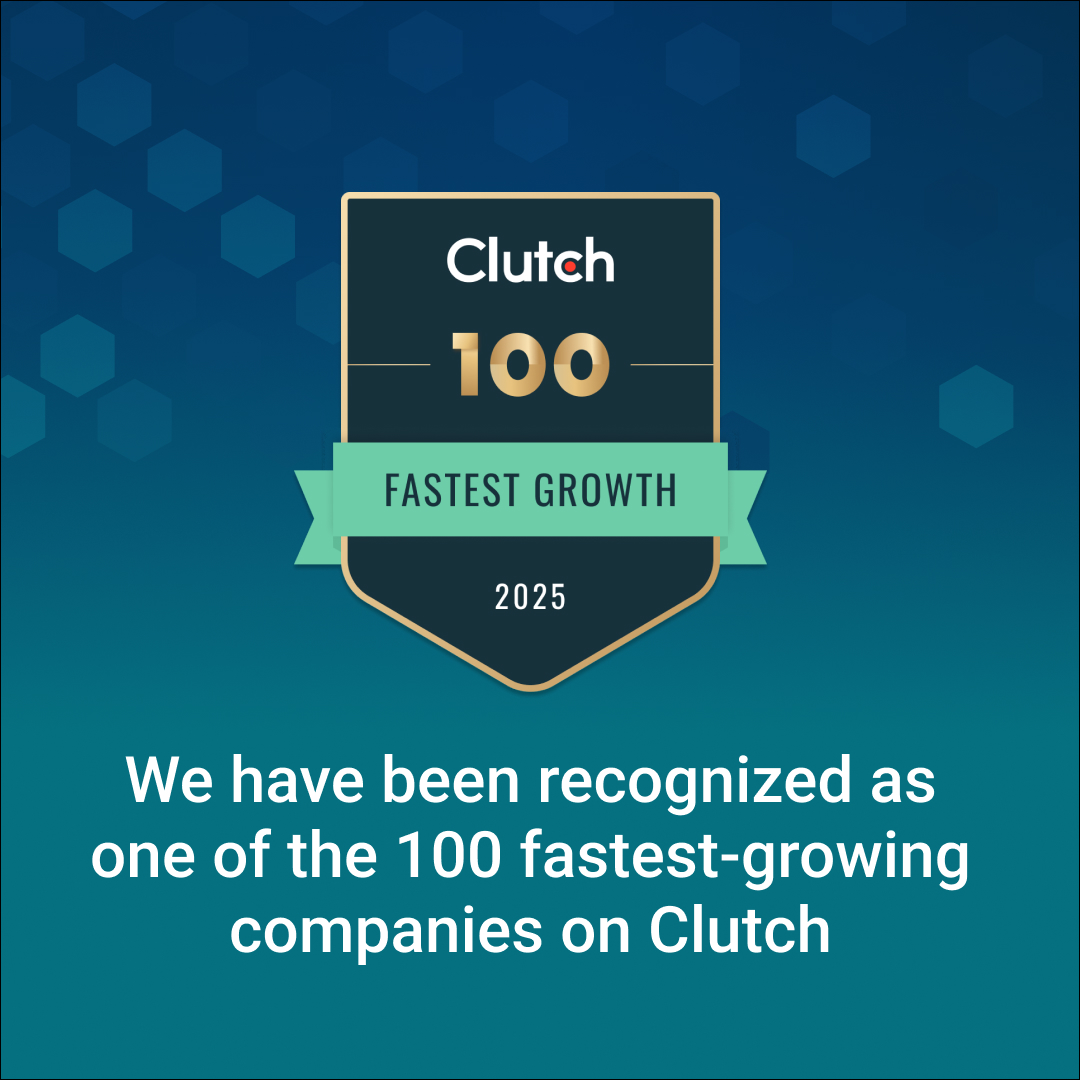Did you know that employment in software development roles, including application engineering, is projected to grow by 22% between 2020 and 2030? This surge significantly outpaces the average for all other occupations, highlighting a transformative shift in how businesses leverage technology. Artificial intelligence (AI) has become a significant force worldwide, sparking transformation and revolutionary developments across many industries, including engineering. Therefore, application engineers are at the heart of this revolution, bridging the gap between complex business challenges and innovative technological solutions.
As an ITO business, SmartDev has acquired years of experience in building teams of expert application engineers, dedicated to crafting solutions that drive efficiency, enhance user experience, and foster scalable growth. This comprehensive guide delves into the dynamic world of application engineering, exploring its core principles, requisite skills, industry-specific applications, and the emerging trends shaping its future.
Key Takeaways
- Comprehensive Lifecycle Approach: Application engineering covers the full application lifecycle, from planning and development to ensuring solutions are tailored to specific business needs.
- Essential Skills for Success: Successful application engineers possess a mix of technical expertise, problem-solving skills, project management knowledge, and a user-centric approach, all critical for delivering effective, sustainable applications.
- Industry-Specific Applications: Different industries require unique applications and application engineers must adapt solutions to address industry-specific challenges and regulations.
- Future Trends Shaping the Field: Emerging trends like AI-driven development or low-code platforms are set to transform application engineering. Staying updated with these trends is essential to building innovative applications.
1. What is Application Engineering?
1.1. Application Engineering: More than Just Development
Application engineering goes beyond traditional software development; it combines technical execution with strategic business alignment. At its heart, it involves the entire lifecycle of an application. From planning and designing to development, testing, deployment, and maintenance, application engineers take a solution-oriented approach to creating software that meets specific goals and adapts to future needs.
Unlike general software developers, application engineers are highly focused on creating software solutions tailored to unique business needs, focusing on functionality, usability, and scalability. They bridge the gap between high-level business goals and the practical implementation of software solutions that drive productivity and innovation.
1.2. Engineering vs. Software Development: Key Differences
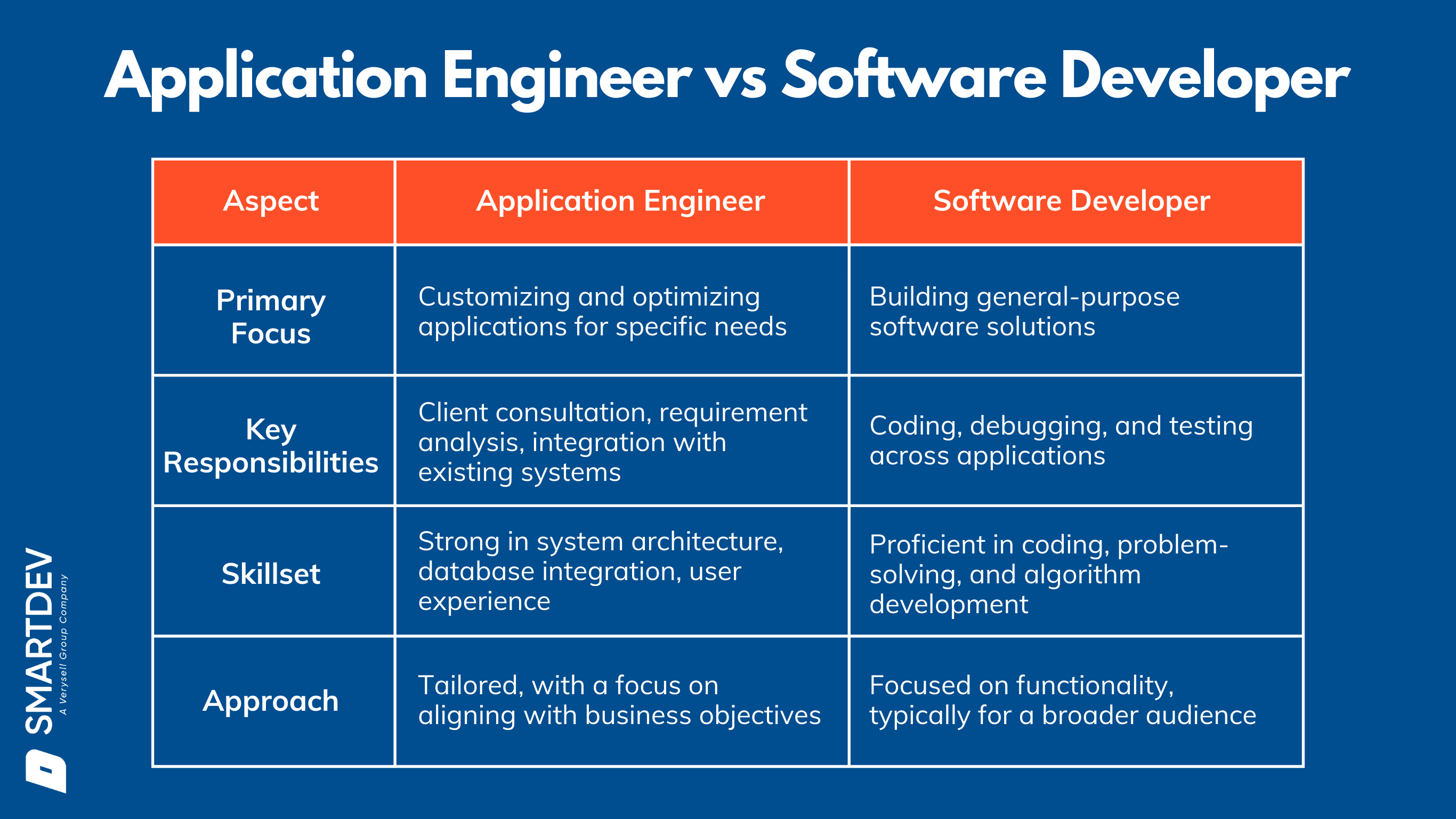
While both application engineers and software developers work on building software, their roles diverge significantly. Developers typically focus on coding and technical execution, whereas application engineers act as liaisons between business needs and technical development. They delve into requirements analysis, collaborate with stakeholders, and ensure that each application is scalable, user-friendly, and aligned with business objectives.
1.3. Why Businesses are Turning to Custom Applications
Businesses today face increasingly complex demands that out-of-the-box software often cannot address. Here’s how application engineering addresses some of the most pressing obstacles:
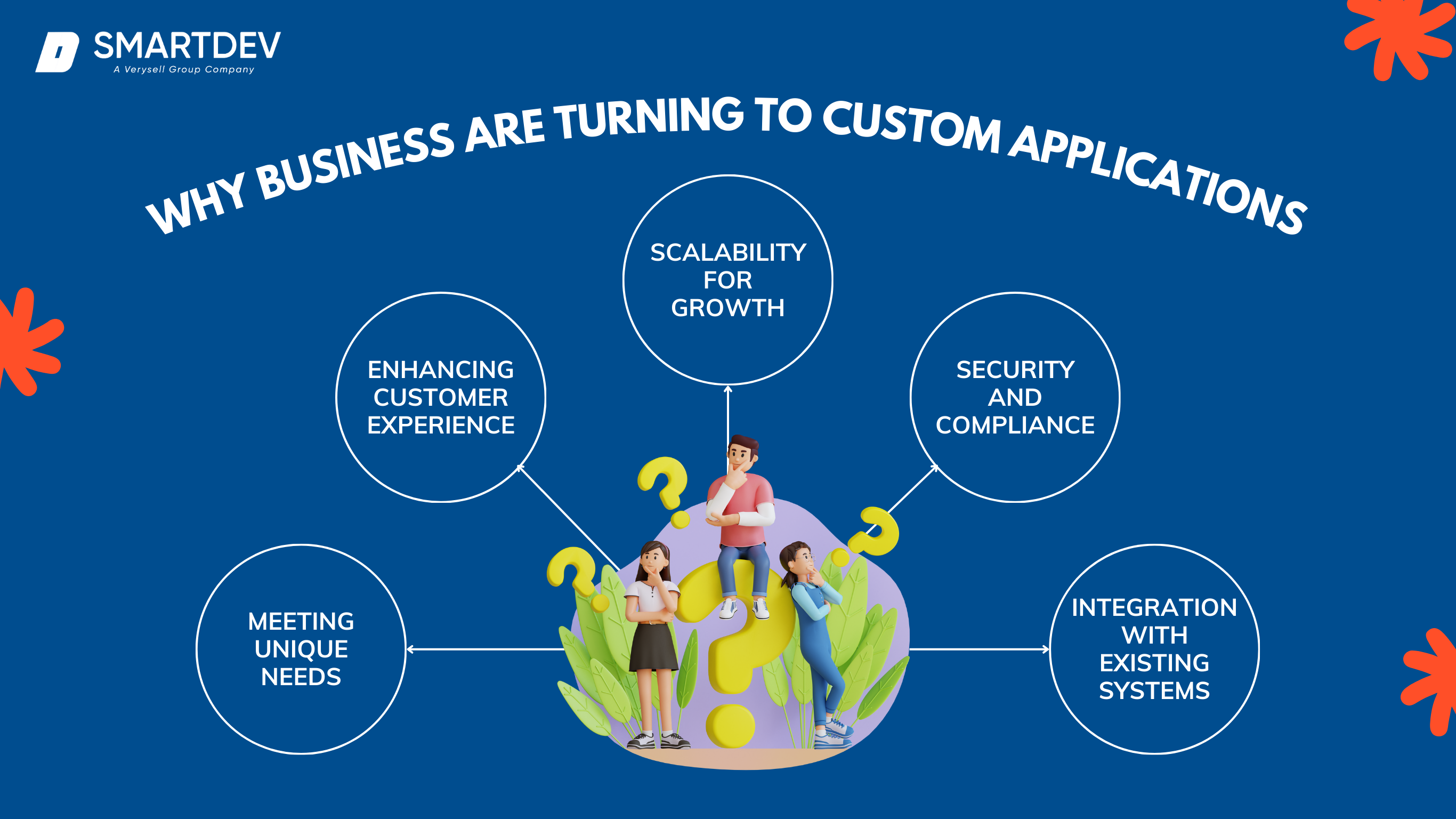
-
Meeting Unique Needs
Off-the-shelf software often lacks the flexibility to handle industry-specific requirements or adapt to unique workflows. For industries with complex compliance standards, such as healthcare or finance, and for businesses with distinct operational models, a customized approach is essential. Application engineering delivers targeted solutions that are fully aligned with operational needs, ensuring that every feature supports business goals.
-
Enhancing Customer Experience
In an era where user experience (UX) is critical to customer retention, businesses need applications that are intuitive, responsive, and tailored to their audience. Application engineers incorporate UX design principles from the ground up, creating applications that offer seamless, satisfying interactions for both clients and internal teams. This focus on experience helps businesses build stronger relationships with users and differentiate themselves from competitors.
-
Scalability for Business Growth
As companies expand, their software must be scaled accordingly without sacrificing performance or reliability. Generic software often struggles with growing demands, creating bottlenecks and reducing efficiency. Application engineering offers a strategic approach to scalability, enabling businesses to grow with confidence by designing applications that can handle increased workloads and additional features as their needs evolve.
-
Security and Compliance
With rising cybersecurity threats and strict regulatory standards, particularly in sectors like finance and healthcare, businesses must prioritize secure and compliant software. Application engineers are trained to incorporate advanced security protocols, compliance features, and data protection measures that safeguard against breaches. By designing with security in mind from the start, application engineering helps businesses mitigate risks and maintain compliance seamlessly.
-
Integration with Existing Systems
Many businesses rely on a network of legacy systems that must work together efficiently. Integrating new software with these existing systems can be complex and risky, leading to potential data silos or disrupted workflows. Application engineering allows for smooth, strategic integration, enabling companies to modernize and enhance their capabilities without disrupting operations or risking data inconsistencies.
Overall, businesses are all aiming to keep up with this fast-paced growth in any industries due to digitalization and globalization. By addressing these challenges with custom solutions, application engineering has evolved into a strategic asset for businesses.
2. Essential Skills for Successful Application Engineers
At SmartDev, our experience working across various industries has highlighted specific skills that set successful application engineers apart. Here, we share the key skills and best practices to focus on as you build your application engineering career.
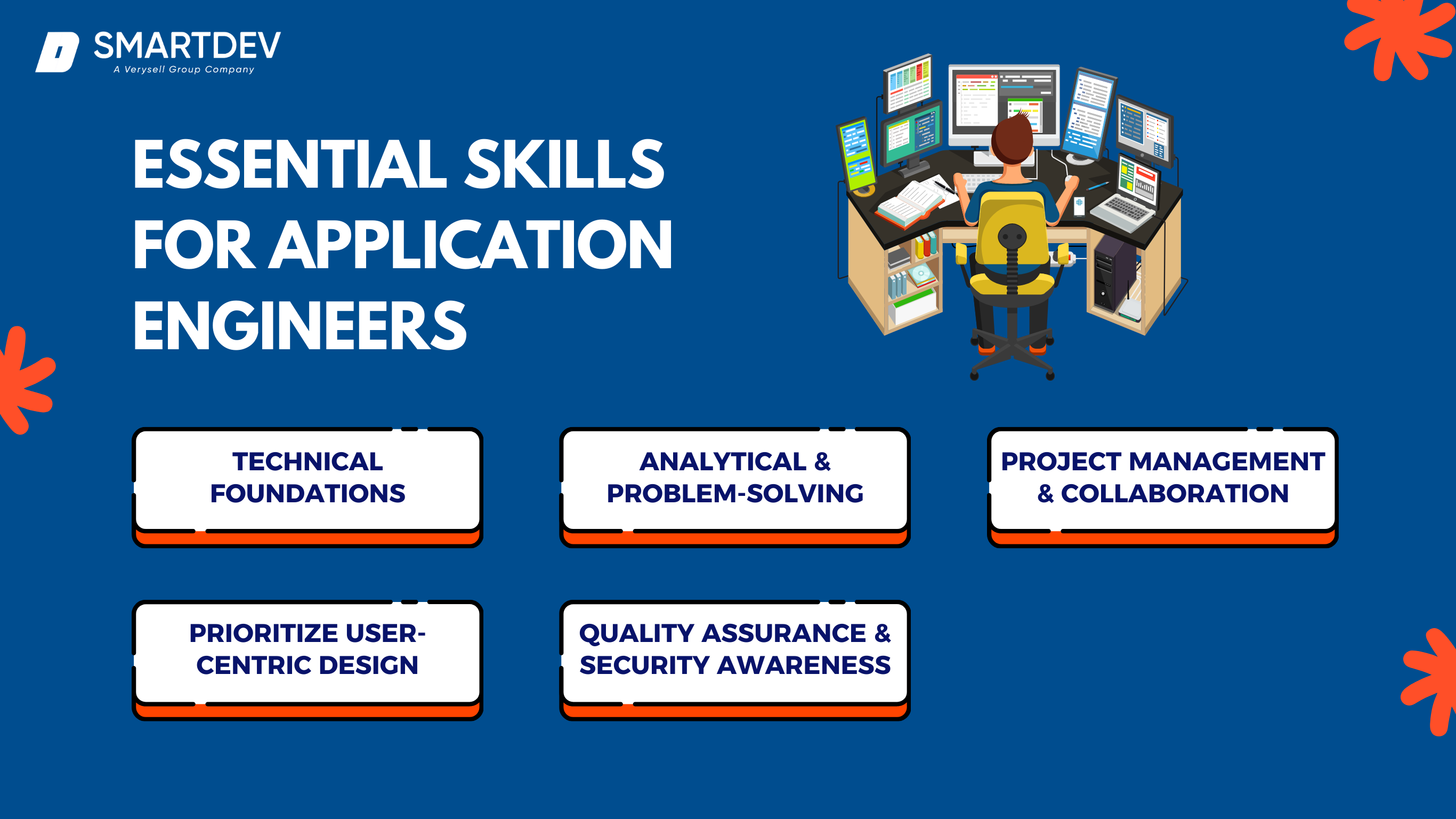
2.1. Technical Foundations
Application engineering requires a deep understanding of programming languages and frameworks, as well as system architecture and database management. Skills in languages like Java, Python, .NET, or JavaScript are foundational, but staying agile and adaptable to new technologies is equally critical. As the industry evolves, application engineers must also become proficient in modern tools, from cloud platforms like AWS or Google Cloud to microservices and containerization technologies that enable scalable solutions.
Staying up-to-date with the latest advancements in these areas isn’t just a suggestion, it’s a necessity. We recommend dedicating regular time to learning and experimenting with emerging technologies that can streamline development, enhance application performance, and improve system resilience. This proactive approach allows engineers to future-proof their skills and deliver solutions that can scale and evolve alongside clients’ needs.
2.2. Analytical and Problem-Solving Abilities
One of the hallmarks of effective application engineering is the ability to navigate complex, often multifaceted challenges. Analytical and problem-solving skills help engineers break down these challenges into manageable parts, quickly identifying efficient and creative solutions. This ability is particularly useful when handling large-scale applications with multiple dependencies or when responding to unique client requirements that may not have an out-of-the-box solution.
Therefore, we emphasize a solution-oriented mindset to everyone. Approach each project with curiosity and a readiness to explore different approaches. When engineers are prepared to dig deeper and view challenges from multiple angles, they’re able to craft solutions that are both innovative and tailored to specific business needs.
2.3. Project Management and Collaboration Skills
Importantly, application engineers don’t work in isolation. They frequently collaborate with cross-functional teams, including product managers, designers, and quality assurance specialists. Familiarity with project management methodologies—especially Agile or Scrum—is invaluable, as it facilitates communication, streamlines project timelines, and ensures that the entire team stays aligned on the project’s objectives.
We suggest developing skills in collaboration tools like JIRA, as well as honing your ability to articulate complex technical ideas to non-technical stakeholders. This balance between technical execution and effective communication ensures that projects move forward smoothly, with all team members working cohesively towards shared goals.
2.4. Prioritize User-Centric Design
Additionally, SmartDev wants to share one insight even the most robust application won’t deliver real value if it’s not intuitive for end-users. While application engineers primarily focus on backend stability and technical design, a working knowledge of user experience (UX) principles is essential. If understanding UX is there, engineers can create applications that are not only functional but also engaging and easy to navigate.
Consider end-user’s perspectives early in the development process and make design decisions that enhance usability, minimize friction, and encourage engagement. Building this empathy for the end-user fosters an engineering approach that aligns technical functionality with actual user needs, ultimately creating more successful applications.
2.5. Continuous Quality Assurance and Security Awareness
In application engineering, quality and security are non-negotiable. Continuous quality assurance—integrating testing throughout the development lifecycle—ensures that applications are reliable, consistent, and perform well under various conditions. Familiarity with automated testing tools like Selenium or TestComplete can significantly improve efficiency, enabling application engineers to detect and resolve issues early.
Last but not least, security awareness is equally essential, particularly when developing applications in sectors like finance or healthcare. Engineers must prioritize security from the initial stages, applying best practices like data encryption, multi-factor authentication, and regular vulnerability assessments. Developing applications with security in mind from the outset is a hallmark of responsible engineering, ensuring applications that not only perform well but also protect user data and comply with regulatory standards.
3. Industry-Specific Applications of Application Engineering
Subsequently, application engineering is pivotal in developing tailored software solutions across various industries, addressing unique challenges, and enhancing operational efficiency. Since we’ve collaborated with numerous clients, delivering customized applications, below, we showcased a few of our work in some of our domains demonstrating the versatility and impact of application engineering.
Case 1 – Finance: Enhance Supply Chain Finance Platforms

In the financial sector, application engineering focuses on creating secure, scalable platforms that streamline complex processes. A notable example is our collaboration with a client to develop a bank-agnostic supply chain finance platform. This solution automates manual financial processes by integrating multiple banks into a single platform, providing users with comprehensive visibility and control over their supply chain finances. The platform offers services such as receivables finance, distributor finance, and invoice discounting for buyers, as well as supplier finance and dynamic discounting for suppliers.
Additionally, it includes value-added services like payment gateways, data analytics, and foreign exchange conversions, significantly reducing operational costs and enhancing decision-making capabilities.
Case 2 – Healthcare: Integrate AI-Speaking Applications

In healthcare, application engineering plays a crucial role in developing tools that improve patient care and communication. We partnered with a client to create an advanced AI-integrated speaking application aimed at mastering communication skills. Our team integrated existing video analysis APIs into a new application, delivering high-quality front-end design, responsive back-end development, and cloud solutions. This application leverages AI to provide users with real-time feedback on their speaking abilities, aiding in the development of effective communication skills.
Case 3 – E-Commerce: Empowering DMT Software House’s Growth

In the retail sector, application engineering is essential for developing solutions that enhance customer engagement and streamline operations. We collaborated with DMT Software House, a company specializing in retail solutions, to provide strategic talent solutions that empowered their growth. By offering specialized expertise and resources, we enabled DMT to expand its capabilities and deliver more comprehensive services to its retail clients. This partnership facilitated the development of innovative retail applications that improved customer experiences and operational efficiency.
4. Challenges in Application Engineering
While application engineering is essential for creating high-quality, targeted applications, it comes with its own set of challenges. Let’s look at a few common issues application engineers navigate:
4.1. Balancing Customization with Scalability
Applications need to be tailored to specific business needs while remaining flexible enough to grow over time. The challenge here is to strike the right balance between creating custom features for the client and designing a scalable infrastructure that can handle increased demand or new functionalities.
Example: Imagine a small e-commerce store needing a custom inventory management feature. While a tailored solution meets their current needs perfectly, they might face performance issues if the business scales rapidly. If not built with scalability in mind, the application might require a costly overhaul to accommodate more products, users, or new features.
4.2. Managing Security Risks
Application engineers, especially those working in finance and healthcare, need to ensure that the software adheres to strict security standards to protect sensitive user data. This involves implementing robust authentication methods, data encryption, and regular security audits.
Example: Consider a healthcare application that stores patient records. If security measures like multi-factor authentication and encryption aren’t in place, these sensitive records could be at risk, exposing both the users and the company to significant privacy and legal issues. Security in application engineering isn’t just a feature, it’s a necessity.
4.3. Meeting Diverse User Requirements
User requirements can vary widely, and application engineers must balance these differences within a single application. The challenge is to develop a solution that is intuitive for end-users while meeting all functional requirements from various stakeholders.
Example: For a corporate expense tracking application, executives might need high-level analytics, while employees simply want a quick way to submit expenses. Engineers must create a user-friendly interface for employees while offering a dashboard with in-depth reporting capabilities for the executive team. This requires carefully designing the application to meet both basic and advanced user needs without making it overly complex.
4.4. Dealing with Legacy Systems
Many businesses rely on legacy systems—older software or hardware platforms that are still essential for daily operations. Application engineers often face the challenge of integrating new applications with these systems without disrupting existing workflows.
Example: A bank might still use a decades-old system for handling account information but wants to introduce a mobile app for their customers. The application engineer needs to ensure that the new app seamlessly accesses data from the legacy system, despite possible differences in data formats or outdated protocols.
4.5. Time, Budget, and Resources
Like any engineering project, application engineering is often constrained by time, budget, and resource limitations. Application engineers need to optimize these factors without sacrificing quality or functionality, which can be challenging.
Example: A client might need a fully operational e-learning platform within a tight timeline for an upcoming semester. The challenge is to develop a functional, user-friendly application within budget and time constraints, requiring the engineer to prioritize key features and find efficient ways to work within the set limits. In these cases, Agile or iterative development can be beneficial, allowing for a gradual rollout of features that meet immediate needs.
5. Tools and Technologies in Application Engineering
A well-equipped application engineer relies on a robust toolkit. Here are some of the most widely used tools and emerging technologies in application engineering:
- Integrated Development Environments (IDEs): Essential for coding, debugging, and testing applications efficiently.
- Version Control Systems: Enable engineers to manage and track changes, ensuring that teams can work collaboratively and resolve conflicts quickly.
- Project Management Tools: Manage project timelines, track progress, and facilitate team collaboration, especially in Agile environments.
- Cloud Computing Platforms: Build scalable, flexible applications that leverage the power of distributed computing.
- AI and Machine Learning: Used for predictive analytics, personalization, and automation within applications.
- Low-Code/No-Code Platforms: Enable rapid application development, particularly useful for prototyping and non-complex applications.
- IoT: Application engineering in IoT systems is increasingly in demand, requiring engineers to create applications that communicate with a vast array of devices.
6. Future Trends in Application Engineering
Application engineering is evolving rapidly, driven by technological advancements and changing business needs. Staying abreast of emerging trends is essential for professionals aiming to deliver innovative and efficient solutions. Here are 5 new trends that we predicted have a high chance of shaping the future of application engineering beyond 2024.
Trend No.1: Artificial Intelligence (AI) and Machine Learning (ML)
AI and ML are transforming application engineering by automating complex tasks, enhancing decision-making, and personalizing user experiences. Developers are increasingly incorporating AI-driven features such as predictive analytics, natural language processing, and intelligent automation into applications. This integration enables applications to learn from user interactions, adapt to preferences, and provide more intuitive functionalities.
Trend No.2: Low-Code and No-Code Development Platforms
The adoption of low-code and no-code platforms is accelerating, enabling rapid application development with minimal hand-coding. These platforms empower business users to create applications, fostering innovation and reducing development time. Gartner predicts that by 2025, 70% of new applications developed by enterprises will use low-code or no-code technologies, up from less than 25% in 2020.
Trend No.3: Cybersecurity and Data Privacy
With increasing cyber threats and stringent data protection regulations, application engineers are prioritizing security and privacy. Implementing robust security measures, such as encryption, multi-factor authentication, and regular vulnerability assessments, is becoming standard practice. Additionally, engineers are focusing on building applications that comply with data privacy laws like GDPR and CCPA, ensuring user data is handled responsibly and transparently.
Trend No.4: Cloud-Native Applications
The shift towards cloud-native architecture continues, with organizations embracing microservices, containerization, and serverless computing. These architectures offer scalability, flexibility, and faster deployment times, enabling businesses to respond quickly to market changes. By 2025, cloud-native development is expected to be the standard approach for new applications.
Trend No.5: Augmented Reality (AR) and Virtual Reality (VR)
AR and VR technologies are set to redefine user experiences across sectors like retail, healthcare, and education. Meta is leading this innovation with its Orion AR glasses, featuring holographic capabilities and neural wrist-based controls, aimed at broadening practical AR applications. Additionally, Meta has introduced the Quest 3S VR headset and enhanced its Ray-Ban smart glasses with AI, making immersive tech more accessible. These advancements highlight AR and VR’s potential for application engineers, who can leverage these tools to create engaging, interactive experiences across various industries.
7. Best Practices in Application Testing and Quality Assurance
Testing and quality assurance are critical aspects of application engineering. Here are some best practices to ensure that applications perform reliably:
- Automated Testing: Automated testing tools, such as Selenium and TestComplete, allow for efficient, repetitive testing processes that catch errors before applications are deployed.
- Unit and Integration Testing: By focusing on individual components (unit testing) and their interactions (integration testing), engineers can ensure that each part of the application works seamlessly together.
- User Acceptance Testing (UAT): It is the final stage of testing, where the application is tested in real-world scenarios to ensure it meets user requirements and expectations.
- Continuous Quality Assurance: Rather than limiting quality checks to specific stages, continuous quality assurance integrates testing throughout the development lifecycle, improving consistency and reliability.
8. Key Metrics for Measuring Success in Application Engineering
Evaluating an application’s success requires a blend of metrics that capture technical performance, user engagement, and business impact.
8.1. Performance and Stability
Performance metrics such as response time and uptime are essential indicators of how reliably the application operates. Fast response times and high uptime contribute to a positive user experience, while tracking error rates helps identify and address any stability issues that could disrupt functionality.
8.2. User Engagement and Satisfaction
User satisfaction and adoption rates reveal how well the application aligns with user needs. High adoption indicates strong relevance and usability, while gathering direct user feedback highlights both the strengths and areas for improvement. This engagement-focused metric provides valuable insights to guide future updates.
8.3. Business Impact and Return on Investment (ROI)
To determine the application’s business value, ROI measures the financial benefits relative to development and operational costs. Additionally, monitoring feature utilization helps identify which aspects of the application deliver the most value, enabling teams to prioritize enhancements and updates effectively.
8.4. Scalability and Maintenance Needs
Scalability metrics reflect the application’s ability to handle growing workloads or user traffic without compromising performance. Maintenance frequency and update requirements further indicate the application’s robustness, showing whether it’s built for long-term use with minimal interruptions.
These metrics collectively offer a clear view of the application’s performance, user engagement, and contribution to business goals, enabling teams to make strategic decisions on ongoing development and optimizations.
9. The Key Benefits of Application Engineering for Businesses
Application engineering offers several key advantages that make it an ideal solution for businesses looking to optimize their operations and create value in a dynamic environment.
9.1. Enhanced Efficiency
One of the most significant benefits of application engineering is enhanced operational efficiency. By customizing applications to fit specific workflows, organizations can streamline processes, reduce redundancies, and enhance productivity. According to a report by McKinsey & Company, companies that invest in tailored software solutions can see productivity increases of up to 30%. This efficiency translates into faster project completion times and improved resource allocation.
9.2. Cost Savings
While the initial investment in custom applications may be higher than off-the-shelf solutions, the long-term savings often outweigh these costs. These savings come from reduced maintenance costs, fewer software licensing fees, and minimized downtime due to better-aligned systems.
9.3. Scalability and Flexibility
Application engineering allows businesses to create scalable solutions that can evolve alongside their operations. This flexibility is vital in today’s fast-paced market environment where adaptability can determine success or failure. Custom applications can be designed with scalability in mind, allowing organizations to add features or expand capabilities as needed without significant overhauls.
9.4. Improved User Experience
Custom applications are designed with user experience in mind. By involving end-users in the design process through feedback sessions and usability testing, application engineers can create intuitive interfaces that enhance user satisfaction.
9.5. Competitive Advantage
In a crowded marketplace, having custom solutions can provide a significant competitive edge. Businesses that leverage application engineering can respond more quickly to market changes, implement innovative features faster than competitors using generic solutions, and ultimately deliver better value to their customers.
Ultimately, the flexibility of application engineering allows businesses to create solutions that align with their operational model, ensuring that technology serves their unique goals rather than forcing processes to fit within the constraints of generic software.
10. The Role of Application Engineering in Different Industries
Application engineering is pivotal across multiple sectors, allowing organizations to develop software solutions tailored to their distinctive challenges. Here’s a look at how various industries leverage application engineering:
10.1. Healthcare
In healthcare, application engineering is utilized to create specialized electronic health record (EHR) systems that streamline patient data management. By customizing these systems, healthcare providers can ensure they meet specific regulatory requirements and integrate seamlessly with existing workflows, ultimately improving patient care and operational efficiency.
10.2. Finance
The finance industry employs application engineering to develop custom financial management tools that automate processes such as transaction tracking and compliance reporting. For instance, banks can create tailored applications that provide real-time insights into market trends, enabling quicker decision-making and improved risk management.
10.3. Retail
In retail, businesses harness application engineering to build personalized shopping experiences. Custom inventory management systems can be developed to track stock levels in real-time and provide insights into consumer behavior, leading to more effective marketing strategies and optimized supply chain operations.
10.4. Manufacturing
Manufacturers use application engineering to enhance production processes through custom software solutions that monitor machinery performance and predict maintenance needs. This proactive approach minimizes downtime and increases overall operational efficiency.
10.5. Education
Educational institutions utilize application engineering to create learning management systems (LMS) tailored to their specific curricula and student needs. These custom platforms can facilitate personalized learning experiences, track student progress, and streamline administrative tasks.
11. How Businesses Can Get Started with Application Engineering
For businesses new to this field, getting started with application engineering can feel complex. Here’s a step-by-step guide to simplify the process and help you lay a solid foundation for a successful project.
1. Identify Pain Points and Define Objectives
The first step in any application engineering project is understanding your unique needs. Identify specific areas within your business that could benefit from improved processes, automation, or enhanced data management. By pinpointing these pain points and clearly defining your objectives, you’ll create a focused, results-oriented engineering project.
- Common Pain Points: Are there repetitive tasks taking up employee time? Do certain processes suffer from delays, errors, or data silos? Could your customer experience improve with more streamlined digital tools?
- Defining Goals: With pain points identified, define clear project goals. Whether it’s to automate a specific process, enable real-time data access, or create a more intuitive customer experience, clear objectives will keep the project aligned with your business priorities.
2. Engage with Experienced Application Engineers
When beginning an application engineering project, working with experts is invaluable. Consulting with an experienced application engineering team like SmartDev ensures that your solution is built to industry best practices, with scalability and security integrated from the start. Consulting partners offer guidance on what’s achievable and suggest the latest tools and technologies best suited for your objectives.
- Choosing the Right Partner: Look for engineering teams with a strong track record in application development for your industry. Experienced engineers can offer insights that align with your specific needs, reducing the chances of costly errors and ensuring a solution that truly adds value.
- Planning the Project Scope: Collaborate with your engineering partner to define the project’s scope, timeline, and resource requirements. A structured approach helps keep the project on track and ensures that every element aligns with your business needs.
3. Plan for System Integration and User Training
An often-overlooked element of application engineering is how the new application will integrate with your existing systems and how users will adapt to it. Consider system compatibility and how different departments will interact with the new application to avoid disruptions and ensure a smooth transition.
- Integration with Current Systems: Work closely with your engineers to ensure that the new application integrates seamlessly with existing software and databases. By planning integration from the start, you’ll avoid data silos and create a consistent user experience.
- User Training and Adoption: Proper training is essential for any successful application launch. Allocate time for training employees to use the new application effectively, and consider creating support materials or assigning ‘application champions’ in each department who can guide others through the new system.
4. Measure Results and Continuously Optimize
Application engineering is not a one-and-done effort; instead, it’s a dynamic process that benefits from continuous monitoring and optimization. After deploying the application, set up key performance indicators (KPIs) to gauge its impact on your business. Regular evaluations can reveal areas for improvement, helping you fine-tune the application for optimal performance as your business evolves.
- Track Key Metrics: Common KPIs might include productivity gains, cost savings, error reductions, or customer satisfaction scores. Regularly monitoring these metrics allows you to see the application’s tangible impact.
- Continuous Improvement: Based on your data insights, make adjustments as needed to enhance the application’s performance. This might involve updating features, refining automation, or adding integrations as your business grows.
By following these steps, you’ll be well-prepared to launch an application engineering project that directly supports your operational goals and fosters long-term growth. With the right approach and expert guidance, application engineering can become a powerful tool for business transformation.
12. Conclusion
Application engineering is a vital field that allows businesses to bring tailored, user-friendly applications to life. At SmartDev, our application engineers possess the technical skills, industry knowledge, and innovative thinking necessary to deliver solutions that drive success across multiple sectors. By focusing on customization, scalability, security, and user-centric design, we help clients achieve their digital transformation goals.
In a world where technology evolves rapidly, staying informed about best practices, emerging trends, and new tools is essential. Whether you’re developing a financial app, a healthcare platform, or a retail solution, application engineering is at the core of creating impactful, future-ready applications that adapt to business growth and changing user needs.
FAQs
1. Why is user experience (UX) important in application engineering?
Answer: User experience (UX) is critical because it directly impacts how easily and effectively end-users can interact with the application. In application engineering, we prioritize UX to ensure that applications are intuitive, engaging, and meet users’ needs seamlessly. A strong UX reduces user frustration, boosts engagement, and can lead to higher adoption rates, which ultimately contributes to the application’s success and helps businesses achieve their objectives. Our team at SmartDev integrates UX principles throughout the development process to create applications that provide genuine value to users.
2. How do application engineers handle updates and feature requests after deployment?
Answer: Post-deployment, application engineers handle updates and feature requests by monitoring the application’s performance, gathering user feedback, and prioritizing new features based on impact and feasibility. We use continuous integration and continuous deployment (CI/CD) pipelines to streamline the update process, making it easier to roll out new features or improvements quickly. SmartDev supports clients with ongoing maintenance, ensuring that applications evolve to meet new requirements or adapt to changes in the market, technology, or user behavior.
3. How can businesses benefit from custom applications rather than off-the-shelf solutions?
Answer: Custom applications are built specifically to address a business’s unique challenges, workflows, and goals, unlike off-the-shelf solutions that offer generalized features. Custom applications provide greater flexibility, scalability, and more personalized user experience, which can lead to improved efficiency and user satisfaction. At SmartDev, we work closely with clients to understand their specific needs and deliver applications that support their strategic objectives, provide a competitive edge, and align with future growth plans.
4. How does application engineering adapt to new technologies and trends?
Answer: Application engineering is inherently adaptive, and engineers are always updating their skills and toolkits to incorporate emerging technologies like AI, low-code platforms, and edge computing. By staying updated with these trends, application engineers can create more efficient, scalable, and user-friendly applications. At SmartDev, we invest in continuous learning and adopt best practices, allowing us to integrate the latest technology into solutions that meet modern business needs and provide a robust foundation for future advancements.
5. Can application engineering support integration with other existing systems?
Answer: Yes, application engineering often includes integrating new applications with existing systems or legacy software to ensure seamless data flow and operational efficiency. This integration may involve developing APIs, ensuring data consistency, and managing compatibility. At SmartDev, we have extensive experience in creating solutions that integrate smoothly with other platforms, allowing our clients to enhance their tech ecosystem without disrupting current operations.
6. What metrics are used to measure the success of an application after deployment?
Answer: Success metrics in application engineering vary based on the application’s goals but commonly include user satisfaction, adoption rates, performance metrics like response time and uptime, and business impact such as ROI. At SmartDev, we also track maintenance metrics, scalability indicators, and user feedback to assess the application’s performance and plan further improvements or updates based on data-driven insights.
References
- How To Be an Application Engineer | Indeed Career Advice.
- Software Developers | U.S. Bureau of Labor Statistics.
- Code Sensei, Charting the Roadmap: Top 10 Software Development Trends Shaping 2024 | Dev.to.
- Tech Trends Outlook 2022: Next-Gen Software Development | McKinsey & Company.
- Top Software Development Trends to Look Out for in 2024 | Simform Blog.
- Gartner’s Top Strategic Tech Trends for 2025 | PCMag.
- A Survey on Cloud-Native Architectures and Their Challenges | arXiv.org.
- Meta’s New Quest, Orion AR Glasses, and AI Innovations | AP News.
- Engineering Applications of Artificial Intelligence (AI) | Monolith.


